d0719a0d15940f976dd9a30ec081c00c.ppt
- Количество слайдов: 147

Best Practices in Screening, Assessment and Intervention for Children with Autism Spectrum Disorders Susan L. Hepburn, Ph. D. University of Colorado at Denver and Health Sciences Juneau, Fairbanks, and Anchorage, Alaska March 2008

The Autism Spectrum Similarities = Difficulties in 3 areas: üSocial functioning üCommunication/language üRestricted activities and interests

Possible Differences Amongst Kids with an ASD n n n n Level of cognitive functioning Presence/absence of spoken language Severity of symptoms Specific behavioral expression of symptoms Chronological age Temperament or behavioral style Vulnerability to other conditions, such as attentional, anxiety or mood issues

Social Style n Aloof n Passive n Active-But-Odd

Social Style and Goals Aloof Responding Passive Initiating Active-But-Odd Reciprocity

Children with different styles require different educational approaches

Developmental Aspects of Autism n Symptoms are qualitatively different at different stages of development

Developmental Model of Autism Moderating Features Social/Communicative Functioning Associated Features Outcomes

To elaborate. . n Core features: (1) Social-communicative functioning and (2) ability to adapt (or modify behavior in response to changes in context in a fluid manner) n Moderating features: (1) cognitive ability, (2) language ability, (3) behavioral style n Associated features: (1) attention, (2) anxiety, (3) mood, & (4) problem behaviors

Best practice = developmentallyinformed practice üScreening üAssessment üIntervention Always considering an individual child’s core symptoms of autism, moderating factors, and associated features

Focus of Today’s Talk n What do we know about autism across development in childhood and adolescence? n And what does our developmental knowledge tell us about what we should be doing? Screening n Assessment n Intervention n

Studying Autism in Infancy n Retrospective videotape analysis n n Record review n n See reviews by Charman (2000) and Rogers (2001); Werner et al (2000) e. g. , Johnson, Siddons, Frith, & Morton (1992) Prospective sibling studies n e. g. , Zweigenbaum et al (2005); Landa et al. (2005); Rogers et al. (2005)

Possible Symptoms in Infancy n Deficits in dyadic – “person-to-person” -social interaction Baby is out of sync with caregivers n Lack of social smile n Delayed response to name n n Unusual affect n Lack of appropriate facial expressions Adrien et al, (1993); Baranek (1999); Rogers (2005)

Possible Symptoms in Infancy (cont. ) n Signs of central nervous system dysfunction n Hypotonia n Lack of appropriate facial expressions n Abnormalities in orientation to visual stimuli n Aversion to touch n Signs of poor frontal lobe development n n Poor integration of verbal and nonverbal behaviors Poor attention Adrien et al, (1993); Baranek (1999); Ozonoff et al (2007)

In summary, the results of infant studies suggest that abnormalities are: n Subtle n More likely to involve the absence of rich social behaviors and not the presence of unusual behaviors n Qualitative n A matter of reduced frequency, not complete absence (Charman et al, 1997) n Inconsistent: Presence of intact behavior sometimes does not mean everything is okay (Charman et al, 1998)

Absolute Indicators for a Developmental Evaluation from Birth to 3 Years n No babbling by 12 months n No gesturing by 12 months n No single words by 16 months n No 2 -word spontaneous phrases by 24 months n Any loss of any language or social skills at any time American Academy of Pediatrics, 2005; Centers for Disease Control, 2006; Firstsigns. org)

Characteristics of Autism at Young Ages Toddlerhood: (18 – 36 months)

Best Discriminators of Autism between 18 months and 3 years of age n Social and communicative impairments n n n Less likely look at others Less likely to show objects Less likely to point to an object Less likely to orient to name Less likely to follow attention **Overall: lack of social orienting (Charman & Baird, 2002; Cox et al, 1999; Osterling & Dawson, 1994; Mundy et al, 1994; Stone, Hoffman, Lewis, & Ousley, 1994; Stone, Ousley & Coonrod, 2005)

Sometimes…. n Parents of young children report general behavior problems, with few reports of social difficulties (Charman & Baird, 2002) n Parents of young children notice unusual responses to sensation (Baranek, Foster, & Berkson, 1997) n Regression of communication skills occurs in approximately 15 -30% of cases (Filipek et al, 1989)

By 30 months, many children with autism can… n Follow an adult’s attention (i. e. , “respond to joint attention”; n Indicate a simple request – without coordinated eye contact Mundy et al, 1994) – usually requesting improves in complexity by age 3 (Di. Lavore & Lord, 1995) n Communicate to get access to objects, but not to get an adult’s attention; Stone et al, 1997) n n However, requesting behavior in autism rarely includes coordinated eye gaze, gesture, and/or vocalizations (Stone et al, 1997) Manipulate another person’s hand like a tool to send a message (Stone et al, 1997)

Characteristics of Autism at Young Ages Preschool Years: (3 – 5 years)

Discriminating Items on Screening Tools for Preschool-aged Children (3 – 5 years) n Rarely performs simple actions with a doll n Rarely engages in pretend play n Rarely integrates gestures and/or eye gaze with attempts to communicate n May respond better to an adult’s bid for attention, but still has trouble with initiating joint attention n n Fewer shows and points to share attention Imitation is not spontaneous, and/or is often of poor quality Robins et al, 2002; Stone et al, 2005; Wetherby & Woods, 2004

Compared to Typical Development… § Remarkably, typically-developing children do many of the behaviors lacking in 4 -year olds with autism by the end of their first or second years of life (Carpenter, Nagell, & Tomasello, 1998; Fenson et al, 1994) § These behaviors are associated with word learning (Tomasello, 2001) § And social understanding (Charman et al, 2000)

Autism q Lack of social interest q Limited use of pointing q Poor nonverbal communication q Poor imitation skills q Limited pretend play RELATIVE to overall developmental level Vs. Developmental Delay Any impairment in social or communicative behavior seems consistent with the child’s mental age Development is evenly delayed; few splinter skills (Lord & Pickles, 1996)

Characteristics of Autism at School Age Elementary Years: (6 – 11 years) Middle School Years (11 – 14 years) High School Years (14 – 18 years) Transition/Young Adulthood (19 – 22)

Developmental Challenges During Elementary Years Play gets more cooperative n Social groups form (in and out) n Planning and other executive function skills become more important n Social demands for conformity increase n Social relationships are more complex n Increased reliance on nonverbal cues and subtlety of social signals n May be more self-awareness of differences, particularly around the 3 rd grade n

Around Puberty…. n n n Some children become more anxious Some become a bit overwhelmed by the organizational demands of middle school Some show some problem behaviors that haven’t shown for a long time Some have questions about social rules and boundaries and need some psychoeducation Important time to monitor for overall well-being

Quality of Life for Teenagers n n Does he/she have a favorite activity or passion and are there opportunities to enjoy this often? Are there chances to spend time with other kids of similar ages and interests? Is there a chance to get exercise and have time outside? Are there expectations for taking personal responsibility at home and at school?

Critical Issues of Late Adolescence (Ozonoff et al. , 2002) n n n n Finding support people other than parents Disclosure Sexual development Romantic relationships Identity Development Depression and anxiety Seizures or other neurological symptoms (e. g. , tics)

Implications for Screening Across childhood and adolescence

Essential Elements of Screening n Developmental history (e. g. , milestones, first concerns) n Medical history n Family history n Cognitive/developmental assessment n Needs to include interview and observation

Best Practice in Screening n If you hear concerns about nonverbal social-communication behavior linked with concerns about rigidity – refer for screening n Gather both parent report and direct observation data n Integrate observations from a multidisciplinary team n Directly assess social reciprocity (Charman & Baird, 2002; Filipek et al, 1999; Lord & Risi, 1999; Rogers, 2001; Sandler et al, 2001)

Best Practice (cont. ) n Obtain information from unstructured situations n Consider the child’s access to social experience n Clinicians should seek training on semi-structured interviews to expand their knowledge of autism at different levels of development– even if they don’t use them all the time (Charman & Baird, 2002; Filipek et al, 1999; Lord & Risi, 1999; Rogers, 2001; Sandler et al, 2001)

Best Practice (cont. ) n Include a medical and developmental history n Provide various types of social presses in interaction with child (Charman & Baird, 2002; Filipek et al, 1999; Lord & Risi, 1999; Rogers, 2001; Sandler et al, 2001)

Consider the known genetic risks n 5% of families with a child on the autism spectrum will have another n This translates to 5 in 100, or 50 in 1000 n Typical rate is 1 in 1000 n Risk increases from 1 to 50 per 1000 Or…. q If you have a child with autism, you have a 19 -out-of-20 chance that a future child will not be autistic Keep in mind. . . The risk of having a second child with some features (but not the whole picture) is thought to be higher (Le. Couteur et al. , 1996; Rutter et al, 1996; Szatmari, Jones, Zwaigenbaum, & Mac. Lean, 1998)

Challenges of Screening for Autism in Young Children n n Autism can occur with other conditions Hard to know how good the standardized tools are for early identification Reliability of early diagnosis is still being assessed It is still difficult to predict prognosis (Charman & Baird, 2002)

Remember how different the picture can look in young children (Dixon et al. , 2005) n Majority of toddlers with autism do NOT display the following DSM-IV symptoms: Impaired conversation n Adherence to routine n Stereotyped language n Restricted interests n Preoccupations with parts of objects n

Screening Instruments for Young Children n Within the general population: n Checklist for Autism in Toddlers (CHAT; Baird et al, 2000; Baron-Cohen et al, 2000) n Within a clinically-referred population: Modified CHAT (M-CHAT; Robin et al, 2001) n Screening for Autism in Toddlers (STAT; Stone, n Coonrod, & Ousley, 2000 n Pervasive Developmental Disorders Screening Test (PDDST; Siegel, 1999)

New Screening Tools for Young Children n STAT – scoring system for children between 12 -24 months (Stone et al. , 2005) n First year Inventory (FYI) (Watson et al. 2005)—screening 12 month olds in general population for risk of ASD n Language impairments in ASD (Zwaigenbaum et al. 2005); less vocalization overall and more atypical vocalizations n AOSI (Bryson et al, 2007): development of instrument to measure autistic behaviors in very young children (beginning at 6 months)

Why screen after age 5? n Some bright children, particularly those who are not high in activity level, may not be identified in the preschool years n The impact of having high-functioning autism can hit harder after preschool – and more kids need help n Due to increase in organizational demands n Due to increase in abstract (not rote) material in 2 nd-3 rd grade n Due to decreased opportunities to learn n Some severely-impaired, developmentally delayed children are misdiagnosed with autism in preschool years, and SES factors may influence early identification process (Desposito, 2002) n A formal identification of an ASD can help to guide interventions and promote understanding of why the student behaves as he does

Screening Tools for School-Aged Children n Social Communication Questionnaire (SCQ; Lord et al. , 2003): parent interview, very short version of ADI-R; yes/no responses, best for children 5 and older, score of 15 is “at risk” n Autism Behavior Checklist (Krug, 1989): Teacher or parent checklist, symptoms consistent with classic as opposed to atypical presentation, may over-identify kids with MR as having autism…

Screening for high-functioning or atypical autism n Asperger Syndrome School Questionnaire (ASSQ; Ehlers, et al. , 1989); normed on several thousand school-aged children in Europe, being piloted in US through CADDRE project n Children’s Communication Checklist (Bishop et al, 2003); teacher or parent checklist or interview that captures information on child’s use of pragmatics (social communication)

Sample Questions from the ASSQ n “can be with other children, but only on his/her terms” n “has clumsy or awkward movements or gestures” n “uses language freely, but fails to make adjustments for his listener” n “has a literal understanding of language” n “has difficulties completing daily routine activities”

Implications for Assessment Across childhood and adolescence

The Family’s Experience with Diagnosis: Is it a …. n n n n Hearing problem? Language delay? Global developmental delay? Is it a general behavior problem? Seizure disorder? Genetic disorder Metabolic or gastrointestinal disorder? Auto-immune disorder? n n n n n Go to the audiologist Go to Child Find Go to the speech pathologist Go to a psychologist Go to your pediatrician Go to a neurologist Go to a genetics clinic Go to a GI doctor Go to a nutritionist Go to a DAN doctor

Areas of Assessment n n n n Developmental/cognition/academics Strengths, preferences, learning style Play and social interaction Communication, language, speech Adaptive behavior Fine/gross motor Family functioning and resources

Developmental/Cognitive Assessments n Consider standardized measures that assess both verbal and nonverbal functioning Preschool: Mullen Scales of Early Learning or Bayley Scales of Infant Development Kindergarten +: Differential Abilities Scale, Stanford-Binet-V, K-ABC, WISC-IV n Sometimes, examine nonverbal cognitive functioning more deeply (e. g. , Leiter-R, Merrill-Palmer, Ravens Matrices, C -TONI)

Communication Skills n Range of communicative functions n n n Behavioral regulation Coordinating joint attention Ability to synthesize forms n n Gestures Eye gaze n Spontaneity of use n Social directedness of communication n Profile of receptive and expressive abilities

Language Skills n Receptive ability n Expressive ability n Pragmatic skills n Functional/spontaneous use of language on a daily basis (e. g. , frequency and complexity) n Symbolic play

Speech Skills n Oral-motor integrity n Range of vocalizations n Spontaneity of vocalizations n Ability to imitate sounds or produce on cue n Volume, prosody, etc.

Adaptive Behavior Assessment n Scales of Independent Behavior - Revised (SIBR; Bruininks et al. , 1996) n Vineland Adaptive Behavior Scales (Sparrow et al. 1984; teacher and parent forms; supplementary norms for autism) n AAMD Adaptive Behavior Scales (Lambert et al. , 1993)

Could the child have autism? First Step: Parent Interview n n n Presenting problems and concerns Medical and developmental History Social and family history; family functioning and resources Current interventions and therapies Autism Diagnostic Interview Revised (Lord et al. , 1994) n social relatedness, communication, ritualistic behaviors; “gold standard”, requires training

Parent/Caregiver Questionnaires about Social and Communicative Development n Social Communication Questionnaire: ages 4+ (SCQ; Berument et al, 1999) n Childhood Routines Questionnaire (Evans et al, 1997) n n Mac. Arthur Communication Development Inventory: best for young children or less verbal children(CDI; Fenson et al, 1993; 1994) Social Responsivity Scale (SRS; Constantino, 2001)

Direct Observation of Social and Communicative Behaviors n Autism Diagnostic Observation Schedule (Lord et al, 1999) is a commonly used assessment tool that provides opportunities to observe subtle social and communicative behaviors Developmentally sensitive n Can inform interventions n Can be used across the lifespan n

Challenges Using the ADOS n Requires clinical experience with autism spectrum disorders n Requires a lot of practice to administer and score n Requires that you sit back and not over-scaffold or do your job too well

Best Practice n Seek training through the University of Chicago or certified n Maintain a core group of staff to administer and co-score n Practice regularly n Use in combination with other measures - Especially parent n Know the limits and the strengths of the tool n Know how to talk to the parents about the results trainer and follow the recommended training protocol assessments report

Implications for Intervention For Young Children

Cascade Theory (Rogers, Pennington, Loveland) n Maybe there are several early deficits that conspire to pull the child away from active involvement with the social world n And maybe this restricts their access to social learning, so that they miss out on learning opportunities n And maybe that’s why some kids get worse and worse, and others get better and better

The key to outcome for children with autism might be… n Active engagement in the social world Active involvement with peers and adults n Lots of practice with difficult social and communicative interactions n Consistent exposure to new situations n Persistence, even when it’s hard n Setting small goals and ensuring success n

Which is best delivered through… n n n Early intervention in an integrated, multifaceted intervention program Developmentally-focused approach Delivered in many different formats 1: 1 and highly structured n Natural routines and daily activities n For a review: see National Council on Research, 2001

Goals for Intervention with Young Children n Increase active engagement in social and communicative interactions Teach in multiple real-life settings Increase the opportunities for sharing attention and affect with the child with autism n n n Use routines and predictable, physical activities Alternate following child’s lead with leading the child Actively teach following and initiating joint attention, as well as imitation skills

Teaching Joint Attention (cont. ) n Set up motivating activities that encourage attention and interest n Prompt the shared attention response and reinforce with continued activation of the toy (or another natural consequence) n Practice, practice – Kasari et al. (2004) are doing 10 -minutes per day for 5 days a week and showing strong skill development in preschool children within 7 weeks

Imitation n Imitation is the basis for cultural learning n Imitation ability is strongly influenced by one’s ability to generalize n Imitation leads to language learning in typically developing children, as well as social-emotional understanding

Implications for Intervention For School-aged children

Overview of Interventions n Supporting the “Master Planner of the Brain” n Educational modifications n Minimizing interfering behaviors in the classroom n Improving social competence n n n Naturalistic or Peer-Mediated Narrative or Cognitive-Behavioral Direct Instruction

I. Supporting the “Master Planner” of the Brain Helping with attention, organization, inhibition, initiation, and sustaining attention

3 Kinds of Attention Problems n Shifting attention n Sustaining attention From own agenda to another’s agenda n n From favorite topic to less preferred topic n n From internal world to external world n n n Missing the forest for the trees n n From self to other Short attention span Tendency not to finish what has been started Easily distractible n Overly focused on details Missing the “big picture”

Helping Children Shift Attention n Visual cues to focus attention n Advanced warning of shift in attention n Clear endpoints for activities n Routine for shifting attention n Practice attending to nonverbal cues

Helping Children Sustain Attention n Clear indication of how long attention should be sustained n Provide frequent breaks n Reinforce/reward appropriate attending n Give them a task to do – need some kind of active involvement in activity n Reduce distractors in the environment n Give directions 1 step at a time

Sustaining attention (cont. ) n Consider seating the child towards the front of the classroom near good peer models n Be aware that too much auditory information without visuals is difficult to attend to for most of these kids n Give specific listening assignments (e. g. , list of words to check off when heard)

Helping Children to Focus on the Whole as the Sum of the Parts n Provide verbal and visual cues concerning the “big picture” n Highlight the most important concepts n Explicitly link main ideas and supporting ideas

Structured Teaching Structured teaching examples were downloaded from the Wisconsin Department of Special Education website: www. specialed. us/autism/early/ear 11. htm Stokes, S. (2005). Effective Programming for Young Children with Autism (Ages 3 -5)by. “Written Susan Stokes under a contract with CESA 7 and funded by a discretionary grant from the Wisconsin Department of Public Instruction. ”

Allow a headstart on transitions n n Student may need more time to organize self for next activity For some students, chaos of other children making a transition is overwhelming – see if student can start earlier or later than other students Whenever possible, reduce transitions Use buddy system for room changes

II. Educational Modifications Contributions by: Sally Ozonoff, Sue Thompson, Jennifer Stella

How to teach new concepts (Klin & Volkmar, 2001) n Explicitly n Rote/rule-governed n n Verbally (if Aspergers’) Visually (if High-functioning Autism) n Parts-to-wholes n Sequentially

If the child processes slowly: n Avoid timed tests n Encourage completion – provide visual cues for starting and stopping and require only enough work that child can finish with other students and experience closure n Require completion of part of assignment

If the child struggles with handwriting… n n n n Consider oral tests or projects instead of papers Encourage typing assignments Reduce amount of copying that must be done Make sure worksheets have enough response space for large writing Use multiple choice instead of fill in the blank Emphasize quality, not quantity See if child can purchase school books and highlight (instead of taking notes)

If the student has visual-spatial weaknesses that make math difficult… n n n May need visual cues to align numbers in math problems, use decimal points, dollar signs, etc. Provide a step-by-step approach to solving problems Encourage “talking through” word problems Try to reduce amount of repetitive writing Give an example of a completed assignment

Monitor for reading comprehension n Some students will become expert “decoders” without truly understanding what they are reading n Actively teach how to identify main ideas, supporting points, character perspectives, etc. Can be done in a rule-based approach. n Provide the student with the text the night before so that he/she can preview it

Be ready for “parallel activities” n If an activity is appropriate for the other students, but is likely to be frustrating for the student with HFA, consider designing a parallel activity that teaches the same concepts but in a different way. Allow students to choose which activity to do.

Use Computer-Based Instruction n Practice skills with educational software n n Fast For. Word for phonological processing and other important literacy and language skills Interactive CD-ROMs for narrative structure, science, math, special interests n Practice writing via email n Practice research via internet

Be careful about overwhelming the student with homework n Families often report that homework is a significant stressor n When giving homework, be sure to give complete instructions n Whenever possible, provide study hall towards the end of the day with a tutor available to complete homework n Whenever possible, set a homework routine

Use an assignment notebook n n n Teacher takes the lead in monitoring its use Student will need to be prompted to add/delete assignments Use existing systems that look “normal” – Daytimer, etc.

Break assignments down into steps n Use clearly numbered sequences to illustrate progression n Webs or flowcharts might be useful n Actively involve student in monitoring completion of assignments

For large assignments… n Show student how to n break large tasks into steps and check-off when each step is n completed – observe completed steps, student may not report well Have regular meetings with student to monitor progress Send written description of large assignments (with due dates and steps) to parents

III. Minimizing Problem Behaviors that interfere in classroom activities

Commonly reported challenging behaviors in the classroom n n n Interrupting and other n impulsive verbal behaviors n Resistance to changes n in routine Insistence that certain n rules be followed n Concrete style n Poor handwriting Difficulty accepting mistakes Little patience Driven quality Social vulnerability Distractibility Perseverations or obsessions

Consider the message the behavior is sending n n n Is confused, needs help but has difficulty communicating under pressure Feels negative affect (e. g. , anxiety, worry, sad, mad) and doesn’t know how to manage it physiologically and behaviorally Wants to escape Craves predictability Wants to interact, doesn’t know how Thinks he can’t do something well, so doesn’t try

Avoid Contingencies and Instead…. Catch the Student Being Good n Always be on the look out to praise or reinforce good attention, effort, participation, waiting, tolerance, acceptance of change, coping, etc. n Link rewards to effort and participation but provide intermittently and not with a formalized contract ahead of time

Set Clear Limits n n Anticipate challenging situations Share written rules/guidelines with student for specific situations Be explicit, rule-governed, clear, consistent Pick and choose battles

Use clear and specific language to shape behavior n Avoid phrases like “behave yourself” – not specific enough n Tell the student exactly what is expected and for how long: “You need to be sitting quietly and reading your science book until 11: 15. ” n Emphasize words that indicate when – “now”, “later”, etc. and gently redirect if student acts before it is time

Encourage Choice-making n Autonomy is often very important for these students; use it to prevent problems and reinforce effort n Help student identify how choices are perceived by other people

Use Visual Reminders n n Use post-it notes or index cards on the child’s desk to remind him/her of appropriate behavior (e. g. , “raise your hand”) Instead of verbally reminding child, simply touch the card to send the message

Use the Buddy System n n n Encourage the child to watch what another student does and model that behavior Rotate buddies Whenever possible, use same-gender buddies

Minimize down time n Give the child 2 -3 functional activities to engage in when he/she has completed work and is waiting for the next activity n Provide clear rules about behavior during “down time” or independent work.

Use a “ticket out” system n n n Provide a limited number of tickets out of the classroom per day Provide written guidelines to the student for where to go, how long, etc. Determine a safe place to go and/or supervision Teach the student when to use the tickets Reinforce appropriate use

Plan for alternative activities n For example, if cafeteria is too noisy and upsetting, create a plan for eating and going elsewhere n It may not be useful for some students to participate in all classes, assemblies, field trips etc. – make these decisions with parents

When problem behaviors occur n n Label the misbehavior in a calm, neutral manner Whenever possible, allow natural consequences to arise Do not process/discuss problem behavior in the moment Wait for a calm time to discuss what the student could have done differently

Encourage self-reflection n n Help student to identify situations that are particularly challenging for them Help student to create a list of options for responding to these situations in the future Use self-reflection to strengthen self-esteem Demonstrate differences between student’s perspective and others’ perspective

IV. Improving social competence

A. Naturalistic Teaching n Narrating situations (Tony Attwood calls this “being an anthropologist”) n Setting up play/social situations that you can subtly observe and teach through n n n Bring good models into your house/classroom and structure play activities to encourage active participation Prime or prepare student with ASD Choose shared activities that emphasize strengths and are cooperative, not competitive
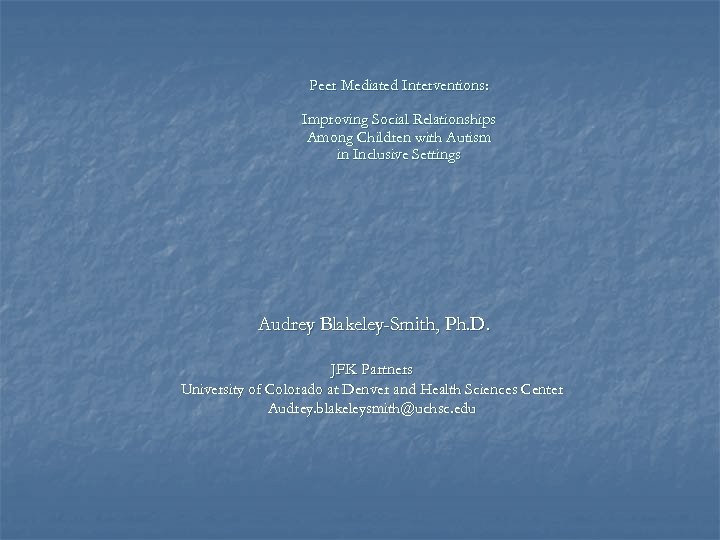
Peer Mediated Interventions: Improving Social Relationships Among Children with Autism in Inclusive Settings Audrey Blakeley-Smith, Ph. D. JFK Partners University of Colorado at Denver and Health Sciences Center Audrey. blakeleysmith@uchsc. edu

Research on Inclusion for Students with ASD n Changes in problem behavior (stereotypies, self-injury) (Lee & Odom, 1996; Mc. Gee, Paradis & Feldman, 1993) n Changes in academic performance (Saint. Laurent & Lessard, 1991; Saint-Laurent, Fournier & Lessard, 1993)

Social Inclusion: What Does the Research Say? n Students in integrated settings spend more time engaged in interactions than students in segregated settings (Center & Curry, 1993)

But What Does this Mean… n Interactions between students with special needs and their peers, are often one-sided and didactic n 78% of student interactions were instructional n <5% of student interactions were social (Farrell, 1997; Hilton & Liberty, 1992)

Social Inclusion: What Do the Peers Say? n Typical peers often report that they have insufficient knowledge and inadequate communication strategies (York & Tundidor, 1995) n Most peers prefer to interact with each other rather than children with HFA (Chamberline, Kasari, Rotheram-Fuller, 2007)
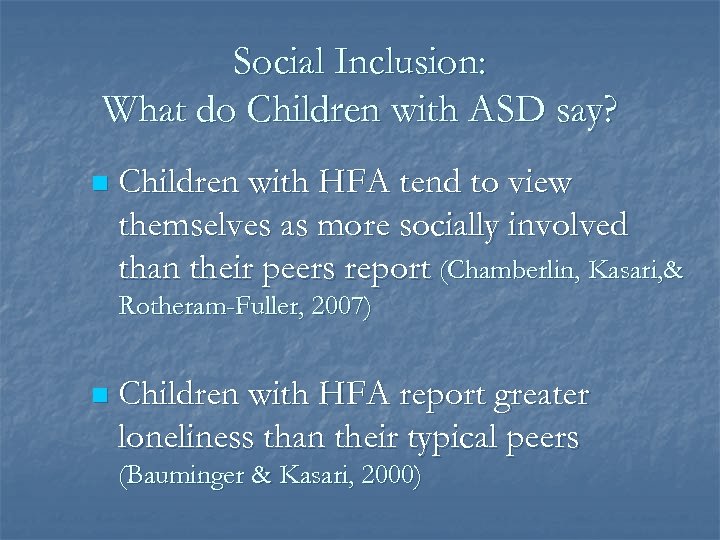
Social Inclusion: What do Children with ASD say? n Children with HFA tend to view themselves as more socially involved than their peers report (Chamberlin, Kasari, & Rotheram-Fuller, 2007) n Children with HFA report greater loneliness than their typical peers (Bauminger & Kasari, 2000)

Peer Mediated Interventions n Choose Peers Who Are… n A part of the child’s social world n Interested n Attentive to adult instruction n Responsive to adult praise

Preparing Peers n Learn about their interests and motivations n Discuss goals of group n Teach how to prompt/help n Role play prompting/helping n Systematically fade reinforcement

Does sharing the autism diagnosis with peers help? n Negative attitudes frequently persist despite providing children with information about ASD (Swaim & Morgan, 2001) n By the 5 th grade, students are no longer as receptive to explanatory information regarding ASD (Cambell, 2006)
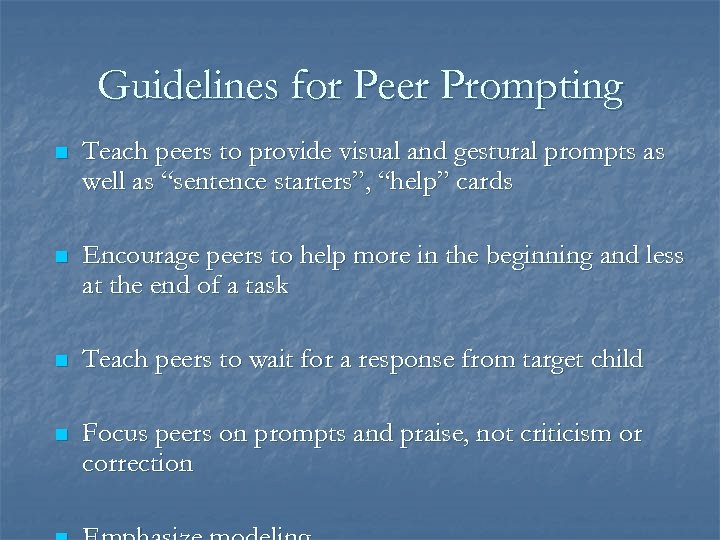
Guidelines for Peer Prompting n Teach peers to provide visual and gestural prompts as well as “sentence starters”, “help” cards n Encourage peers to help more in the beginning and less at the end of a task n Teach peers to wait for a response from target child n Focus peers on prompts and praise, not criticism or correction

Teach Peers to Respond Appropriately n n n Follow and redirect Persistence Patience Change their expectancies regarding the nature of the interaction Change their attributions for the child’s behavior

B. Cognitive-Behavioral Approaches* n Using narrative strategies (scripts, video examples, comic strips, social stories) to clarify basic social concepts n Relying on a child’s cognitive strengths to compensate for lack of social insight *This section relies heavily on contributions from Audrey Blakeley-Smith: Audrey. blakeleysmith@uchsc. edu
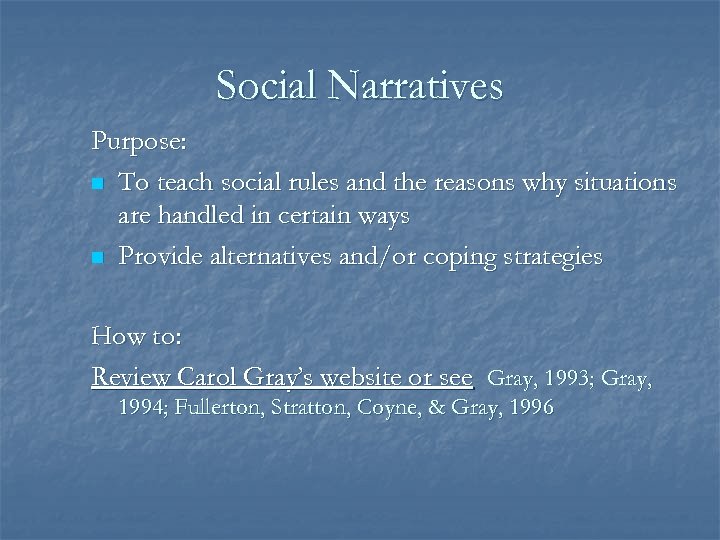
Social Narratives Purpose: n To teach social rules and the reasons why situations are handled in certain ways n Provide alternatives and/or coping strategies How to: Review Carol Gray’s website or see Gray, 1993; Gray, 1994; Fullerton, Stratton, Coyne, & Gray, 1996

Differentiating situations Behavior in library…… …. is the same as in the bank, dentist office, etc. Behavior with little sister…… …. . not the same as behavior with friends Behavior on the playground… …not the same as behavior in the car

Comic Strip Conversations Purpose: § Increase social understanding of difficult situations § Incorporates the use of color and simple drawings to improve the student’s understanding of language and social interactions (Gray, 1994; Fullerton, Stratton, Coyne, & Gray, 1996)

Conversation symbols representing: Talk Think quiet LOUD words Interrupt Listen
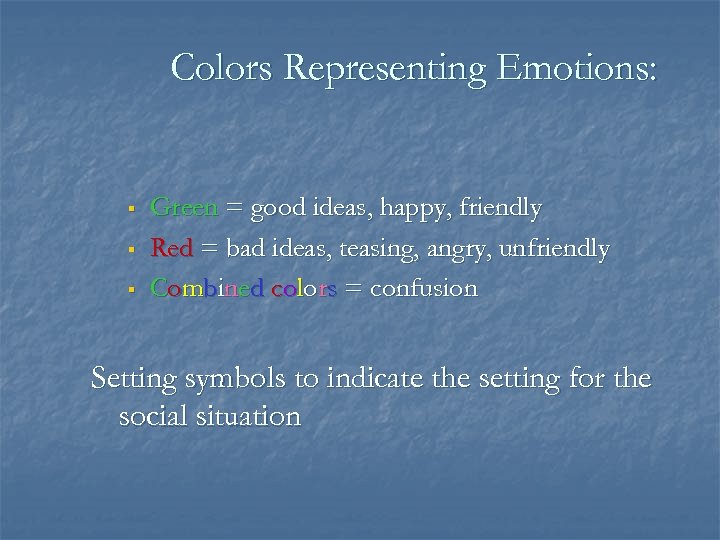
Colors Representing Emotions: § § § Green = good ideas, happy, friendly Red = bad ideas, teasing, angry, unfriendly Combined colors = confusion Setting symbols to indicate the setting for the social situation

Comic Strip Conversations How to: § Review –With the student, draw the difficult social situation; support the student in identifying thoughts and emotions § Practice –Help the student identify more appropriate ways to respond in similar social situations in the future; draw these pictures

Using comic strip conversations to understand social situations n Who is challenging me? n Where are we? n What are the rules? n Who is on my side here? n What happened just before? n What happened just after? n What should I do next time?

Social Scripts How to: § Identify age-appropriate social interactions, language and behaviors § Develop a script § Practice the script with the student § Alter the language/behaviors to reduce rigidity § Support the student to initiate and complete the script with a peer(s)

Social Scripts § Scripted conversations and interactions § E. g. , : Scripts for entering/leaving classroom/activity, going to Mc. Donalds etc. § Scripts for classroom jobs § E. g. , paper distributor: make eye contact or tap shoulder and make eye contact, “Here’s your paper ____”

Video Purpose: § View videos to: § Highlight salient social cues § Highlight specific social communicative behaviors § Create videos to teach: § Imitation, play, community expectations, replacements to challenging behaviors, language and conversation skills

How to View Videos/TV § Have the student observe and interpret nonverbal messages in the show § Have the student make predictions about behaviors § “Video Detective” (Smith Myles & Southwick, 1999; Attwood, 1998)

How to Create Videos § Identify target social behaviors & situations § Videotape familiar peers in those situations engaging in appropriate social behavior § Make the social cues and target behavior the most salient aspects of the video § Have the child view the video and critique their own and others’ behaviors From: Quill, K. A. (2000). Do-Watch-Listen-Say

How to Use the Created Video § View the video regularly (daily) § Preview the video just prior to the relevant situation § Pair the video with other visual cues to use as instructional prompts in the actual situation § Fade video viewing as the skills are mastered in the actual setting

Modeling and Rehearsal Purpose: n To highlight the key behaviors that the child should attend to in developing a social sequence How to: n Peer or adult demonstrates the appropriate social skill for the child to imitate § do in vivo, during role play, or set up situations for practice

Acting Lessons Purpose: § Role-playing and acting may help the child to express emotions verbally and nonverbally § The child may learn to interpret others’ emotions, feelings, and voices

C. Direct Instruction n Adult-directed activities n “Lesson-like” n Involves lots of practice and repetition n Reinforce effort and attention and scaffold enough to ensure success n Goal is to master basics – think of learning a foreign language!!

Individual Work n Include parents whenever possible n Incorporate homework n Use a notebook system n Clearly define goals and review progress regularly in sessions with child and parent
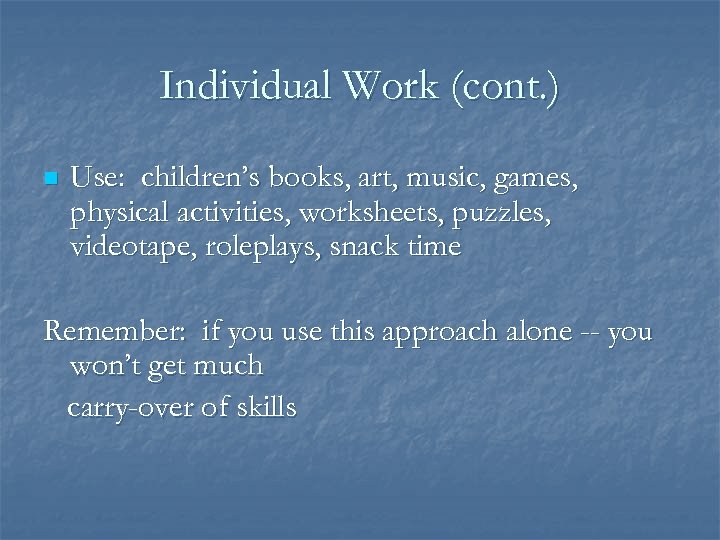
Individual Work (cont. ) n Use: children’s books, art, music, games, physical activities, worksheets, puzzles, videotape, roleplays, snack time Remember: if you use this approach alone -- you won’t get much carry-over of skills

Dyads n Same focus of individual work, but with another child attending also n Choose a peer from the school or neighborhood n Parents still attend and homework is often focused on fostering interaction between the two kids
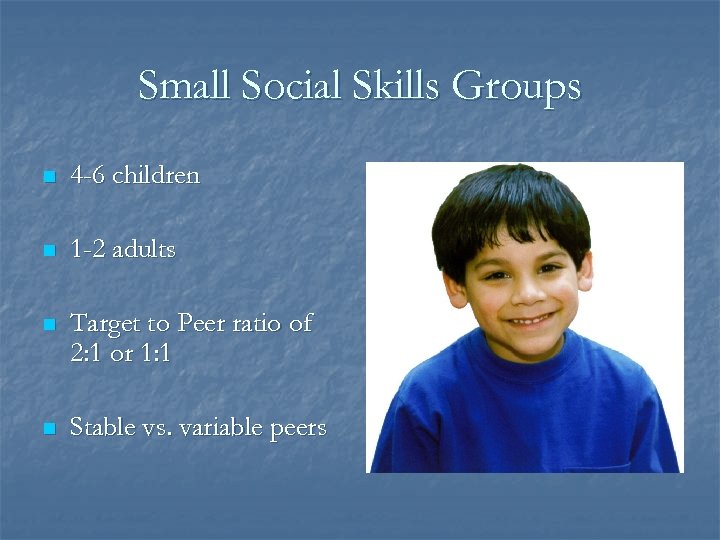
Small Social Skills Groups n 4 -6 children n 1 -2 adults n Target to Peer ratio of 2: 1 or 1: 1 n Stable vs. variable peers

Adult Interaction n Model and narrate appropriate social behavior in a very obvious way n Use humor and lighthearted approach n Provide frequent praise and reinforcement for effort and attention
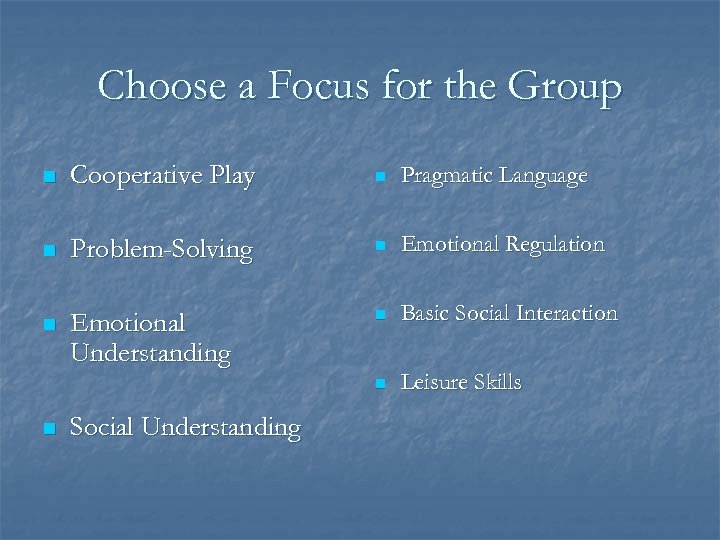
Choose a Focus for the Group n Cooperative Play n Pragmatic Language n Problem-Solving n Emotional Regulation n Emotional Understanding n Basic Social Interaction n Leisure Skills n Social Understanding

Determine Setting/Logistics n Where? n How Often? n How long? n Rules? n Materials?

Planning a Session n Emphasize routine n Provide visual structure n Apply the “ 70/30 Rule of Repetition” n Incorporate special interests

Planning (cont). n Alternate tasks by difficulty, activity level n Teach using multiple modalities n Start each session with a snack n End each session with R+ n Maintain close contact with families

Teaching Activities n Use existing social skills curricula (see reference list) n Use actual situations to fuel lessons within a predictable framework n Know the child’s peer group and be developmentally informed

Dealing with Teasing and Bullies (Ozonoff, 2002) n n n Establish peer buddies and foster good peer relations Teaching classes on tolerance, diversity, learning styles Assertiveness training n Asking for help, finding safe places, walking away, using humor

Resources for Teasing/Bullying n n n Bully-proofing your child: A parent’s guide by Garrity, Mitchell, & Porter (2000). Bully-proofing your school: A comprehensive approach for elementary schools. Garrity et al. (2000). For children: Bullies are a pain in the brain by Trevor Romain

Talking to a Child About Having Autism n Often best to wait until they have questions; often comes up at around age 10 or so n Many good books available to help to educate kids about their condition; see www. futurehorizons. org n Be matter of fact and calm and positive n Discuss it as a way to describe a person’s strengths and challenges, not as a way of capturing the whole person n Have the conversation several times

In Conclusion n Need to think developmentally when planning screening, assessment, or intervention n There are many good resources for intervention for kids of different ages and functioning levels

Thanks to… n Families who participate in our research and clinical activities at JFK Partners of the University of Colorado at Denver and Health Sciences n The Nebraska Autism Spectrum Disorders Network n Laura Maddox, State ASD Coordinator
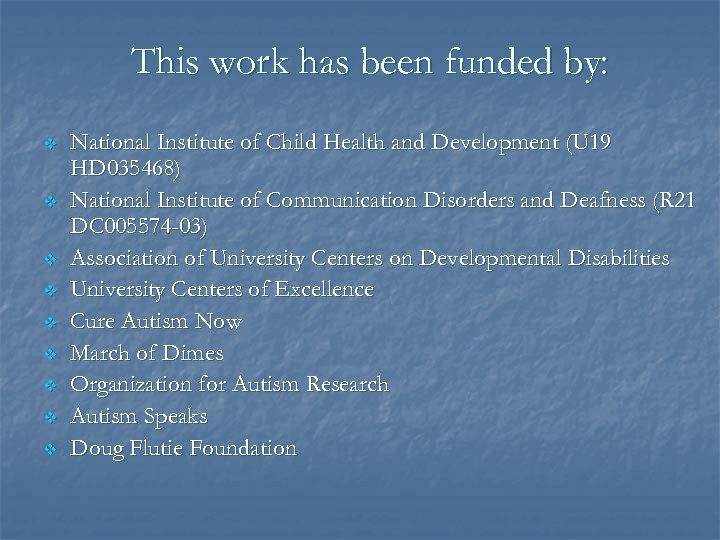
This work has been funded by: v v v v v National Institute of Child Health and Development (U 19 HD 035468) National Institute of Communication Disorders and Deafness (R 21 DC 005574 -03) Association of University Centers on Developmental Disabilities University Centers of Excellence Cure Autism Now March of Dimes Organization for Autism Research Autism Speaks Doug Flutie Foundation

Research Team at JFK Partners and the University of Colorado at Denver and Health Sciences Center Director: Susan Hepburn, Ph. D. Mentors: Sally Rogers Bruce Pennington Corry Robinson Linda Crnic www. jfkpartners. org Collaborating scientists: Deborah Fidler, Ph. D. Judy Reaven, Ph. D. Audrey Blakeley-Smith, Ph. D. Amy Philofsky, Ph. D. Ann Reynolds, M. D. Daniel Mc. Intosh, Ph. D. Eric Moody, Ph. D. Don Rojas, Ph. D. Hilary Coon, Ph. D. Kathy Culhane-Shelburne, Ph. D.

With Appreciation to Many Students and Research Assistants Over the Years n n n Katy Ridge Galit Mankin, M. S. W. Athena Hayes, M. S. Angela John, M. S. Benjamin Yerys, Ph. D. Erin Flanigan Helga Simons Mark Guiberson, Ph. D. Elizabeth Eno, M. S. Susan Murray, CCC-SLP Kym Gilchrist n n n Nancy Lee, Ph. D. Terry Hall, CCC-SLP Renee Charlifue-Smith, CCC-SLP Alison Herndon, MPH Kristina Kaparich, MPH Marissa Sellinger, M. S. Lila Kimel, M. S. Shana Nichols, Ph. D. Tracy Stackhouse, OTR Megan Martins, Ph. D. Mim Ari Norbert Nguiya
d0719a0d15940f976dd9a30ec081c00c.ppt